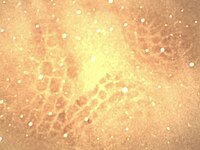This article may be too technical for most readers to understand. (January 2016) |
| Barrel cortex | |
|---|---|
| Identifiers | |
| NeuroLex ID | nlx_81 |
| Anatomical terms of neuroanatomy | |

The barrel cortex is a region of the somatosensory cortex that is identifiable in some species of rodents and species of at least two other orders[1] and contains the barrel field. The 'barrels' of the barrel field are regions within cortical layer IV that are visibly darker when stained to reveal the presence of cytochrome c oxidase and are separated from each other by lighter areas called septa. These dark-staining regions are a major target for somatosensory inputs from the thalamus, and each barrel corresponds to a region of the body. Due to this distinctive cellular structure, organisation, and functional significance, the barrel cortex is a useful tool to understand cortical processing and has played an important role in neuroscience.[2] The majority of what is known about corticothalamic processing comes from studying the barrel cortex, and researchers have intensively studied the barrel cortex as a model of neocortical column.
The most distinctive aspect of the barrel field are the whisker barrels. These structures were first discovered by Woolsey and Van der Loos in 1970.[3] Staining in the whisker barrels is more distinct than that in other areas of the somatosensory cortex. Recognizing that the array was similar to that of the vibrissae (whiskers) on the mystacial pad (region where whiskers grow from) of certain mammals, they hypothesized that the barrels were the "cortical correlates of the mystacial vibrissae" and that "one barrel represents one vibrissa". Whereas small non-whisker areas of barrel cortex correspond to large and sometimes overlapping areas of the body, each much larger whisker barrel corresponds to a single whisker. As a result, the whisker barrels are the focus of the majority of barrel cortex research, and 'barrel cortex' is often used to refer primarily to the whisker barrels. Consequently, much of this article focuses on rodent whisker barrel cortex.